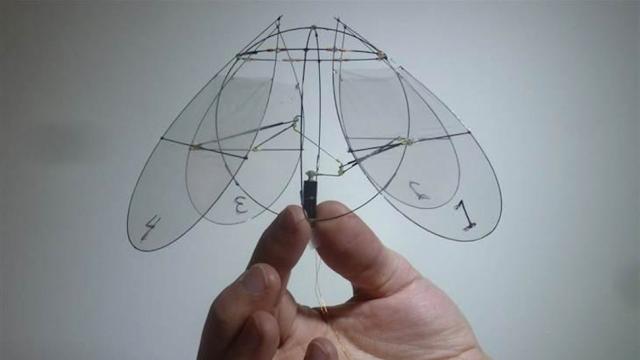Researchers from New York University recently unveiled a drone that “mimics the movements of swimming jellyfish.” Designed by Leif Ristroph, an applied mathematician at NYU, the drone was presented at a fluid dynamics conference in Pittsburgh. It’s tiny and adorable and I want one.
Ristroph wanted to design a drone based on insect wings. However, instead of having the wings sticking out of the side, he had them point downward. When they flapped back and forth it was enough to lift the robot into the air.
Insects have built-in sensors and feedback that help them stay upright, he explained. Drones based on insect wings need the same support. But motors, sensors, and batteries add weight, which becomes problematic for people looking to design smaller and smaller drones. “I wanted to design something that had stability without the stability-sensor needs.”
The design of this drone has come along way from previous efforts. For one, the drone is pretty stable “it would automatically right itself so that it was always flying up…without the need for extra sensors.” After building the drone, Ristroph noticed it “moved remarkably like a jellyfish.”
“One of the important things to keep in mind is that whether it’s an insect, a bird, a fish, or a jellyfish, they’re all playing by essentially the same rules in physics,” said Brad Gemmell, a University of Texas, Austin, ecologist who studies how animals move through the water. Moving through air is similar to moving through water. And regardless of an organism’s shape, if it wants to propel itself along, it has to generate thrust…Jellyfish move in essentially two ways. For smaller species that are a few centimeters in size, they use jet propulsion, he said. The animal contracts its umbrella-shaped bell, squeezing out water behind it and creating a doughnut-shaped ring of water called a vortex. That vortex pushes the jellyfish forward, said Gemmell. Larger jellyfish add a movement called rowing to their jet-propulsion capabilities. Rowing is when the loose edge of their bell flaps around, creating additional vortices that help to generate thrust. Those loose edges almost push against the fluid like a rower pushes an oar against the water, Gemmell explained.
Ristroph is now focused on improving his drone and creating more creative designs for drones. “I’m personally interested in schemes that no one in nature or the engineering laboratory has thought of,” Ristroph said. [National Geographic]

